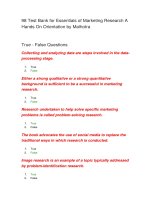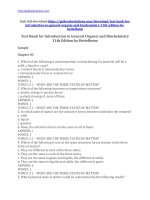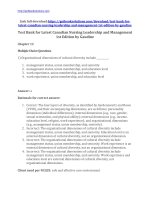Test bank for essentials of human diseases and conditions 6th edition by frazier
Bạn đang xem bản rút gọn của tài liệu. Xem và tải ngay bản đầy đủ của tài liệu tại đây (68.28 KB, 6 trang )
Chapter 01: Mechanisms of Disease, Diagnosis, and Treatment
Frazier & Drzymkowski: Essentials of Human Diseases and Conditions, 6th Edition
MULTIPLE CHOICE
1. Signs of disease
a. always cause symptoms.
b. rarely correlate with symptoms.
c. include abnormal objective findings.
d. are always described by the patient.
ANS: C
Signs, or abnormal objective findings, are the evidence of disease found by physical examination and diagnostic testing. Signs of
disease often correlate with the symptoms.
REF: 2
OBJ: 2
2. Predisposing factors of disease
a. precisely predict the occurrence of disease.
b. make a person or group more vulnerable to disease.
c. never overlap or occur in combination.
d. can all be controlled by prevention.
ANS: B
A person may be susceptible to a greater or lesser degree, due to one or more risk factors that overlap or occur in combination.
Predisposing factors include age, gender, lifestyle, environment, heredity, and immunodeficiency.
REF: 3
OBJ: 3
3. Genetic diseases may be
a. produced by an abnormality in or mutation of the genetic code in a single gene.
b. caused by several abnormal genes.
c. caused by the abnormal presence or absence of a chromosome or an alteration of
d.
the structure of chromosomes.
all of the above.
ANS: D
Genetic predisposition (inheritance) currently is considered a major risk factor. Hereditary factors in disease that appear regularly
in successive generations are likely to affect males and females equally. Hereditary or genetic diseases often develop as a result of
the combined effects of inheritance and environmental factors.
REF: 8
OBJ: 8
4. Benign tumors
a. tend to remain encapsulated.
b. infiltrate surrounding tissue.
c. do not compress surrounding tissue or obstruct organs.
d. do not resemble the tissue of origin.
ANS: A
Benign tumors usually develop slowly and can arise from any tissue. They tend to remain encapsulated and do not infiltrate
surrounding tissue.
REF: 10
OBJ: 7
5. Malignant tumors
a. tend to infiltrate other tissue.
b. tend to bleed, ulcerate, and become infected.
c. may spread to distant sites in the body.
d. are all of the above.
ANS: D
Malignant tumors can represent a serious threat to the health and life of a person. Cancer cells are variable in appearance and
disorderly (anaplastic) with irreversible changes in structure. Malignant tumors have the ability to invade the surround ing tissue.
Often malignant cells enter the bloodstream or the lymphatic vessels and lead to tumor growth in other areas of the body.
REF: 10
OBJ: 7
6. Which statement is true regarding the TNM (tumor, nodes, metastasis) cancer staging system?
a. Assesses the size and extent of the spread of the primary tumor.
b. Is a grading system based on the degree of differentiation of tumor cells.
c. Both a and b are true.
d. Neither a nor b is true.
ANS: A
Although a number of different staging systems exist, the majority of cancers use a TNM system. TNM staging assesses the
neoplasm in three different areas: the size or extent of the primary tumor (T), the extent of regional lymph node involvement by the
tumor (N), and the number of distant metastases (M).
REF: 13
OBJ: 10
Copyright © 2016, Elsevier Inc. All Rights Reserved.
Full file at />
1
7. The tumor Gleason grade reflects
a. the stage of the tumor.
b. the degree of abnormal microscopic appearance of the tumor cells.
c. the location of the tumor.
d. none of the above.
ANS: B
The Gleason grade correlates with extent of disease throughout the body and with prognosis. Analysis of prostate tumor histology
is performed, and the two predominant patterns are recorded and scored from 1 to 5 (1 represents a well-differentiated histology; 5
is the most poorly differentiated).
REF: 13
OBJ: 10
8. Which of the following most correctly states the sequence of an allergic response within the body?
a. Immunoglobulin E (IgE) antibodies enter the body and produce an allergen.
b. The release of histamine sensitizes mast cells and produces symptoms.
c. Exposure to allergen stimulates production of IgE antibodies that can
d.
subsequently trigger symptoms of allergy.
Histamine produces mast cells, which stimulate plasma cells.
ANS: C
Initial exposure to an allergen, which acts as an antigen (a substance that causes the allergic response), stimulates the production of
IgE antibodies, and the person thus is sensitized.
REF: 18
OBJ: 14
9. Systemic manifestation(s) of severe allergic responses include
a. arthralgia.
b. status asthmaticus.
c. anaphylaxis.
d. all of the above.
ANS: D
Severe systemic manifestations of allergic responses include anaphylaxis, serum sickness, arthralgia, and status asthmaticus. For
example, anaphylaxis (anaphylactic shock), the result of a severe systemic allergic reaction, calls for emergency life-saving
intervention.
REF: 17
OBJ: 14
10. Which of the following most accurately states the orderly steps in making a diagnosis?
a. Medical history, physical examination, diagnostic tests, diagnosis, integration of
b.
c.
d.
results, treatment
Medical history, diagnostic tests, physical examination, treatment plan
Physical examination, medical history, radiographs, prognosis, integration of all
information
Comparison of normals, physical examination, history, treatment plan, prognosis
ANS: A
Establishing a diagnosis is a decision-making process in which data collected from the medical history, physical examination, and
diagnostic tests are analyzed, integrated, and interpreted. A diagnosis provides a logical basis for determining treatment and
prognosis.
REF: 21
OBJ: 16
11. Mechanical and chemical barriers, the inflammatory response, and the immune response are
a. risk factors for disease.
b. the combined effects of inheritance and environmental factors.
c. included in the body’s natural defense system against infection.
d. agents that damage deoxyribonucleic acid.
ANS: C
The body’s natural defense systems against infection include (1) natural mechanical and chemical barriers, such as the skin, the
cilia, body pH, and normal body flora; (2) the inflammatory response; and (3) the immune response.
REF: 4
OBJ: 4
12. Immune disorders are the result of a breakdown in the body’s defense system that may generate
a. allergies.
b. autoimmune diseases.
c. immunodeficiency disorders.
d. all of the above.
ANS: D
The immune system is a complex network of specialized cells and organs that has evolved to defend the body against attacks by
foreign organisms.
REF: 17
OBJ: 13
Copyright © 2016, Elsevier Inc. All Rights Reserved.
Full file at />
2
13. Immunodeficiency disorders result from
a. an exudative response.
b. physical trauma.
c. motor vehicle accidents.
d. a depressed or absent immune response.
ANS: D
Causative factors can be primary, manifested by a characteristic decrease in the number of T cells and B cells, leaving the body
unable to adequately defend itself against infection and tumors.
REF: 18
OBJ: 13
14. Which statement(s) is/are correct regarding autoimmune diseases?
a. The diseases allow the immune system to become self-destructive.
b. Many serious diseases have a strong autoimmune component.
c. Both a and b are correct.
d. Both a and b are incorrect.
ANS: C
In autoimmune diseases, antibodies are formed against self-antigens mistakenly identified as foreign.
REF: 18
OBJ: 15
15. Homeostasis refers to
a. disease related to age.
b. internal stability of the body.
c. a chronic disease process.
d. genetic predisposition to disease.
ANS: B
Pathologic conditions involve measurable changes in normal structure and function that threaten the internal stability, or
homeostasis, of the body.
REF: 2
OBJ: 1
16. Pathogens cause disease by
a. invasion of living tissue.
b. destruction of living tissue.
c. intoxication.
d. all of the above.
ANS: D
Infectious diseases are caused by pathogens. The result is tissue damage that has the potential for producing systemic involvement.
REF: 4
OBJ: 6
17. The normal protective physiologic response(s) to tissue injury and disease is/are
a. infection.
b. acute inflammation.
c. cachexia.
d. all of the above.
ANS: B
Acute inflammation, a normal protective physiologic response to tissue injury and disease, is accompanied by redness, heat,
swelling, pain, and loss of function. Widespread inflammation is marked by systemic symptoms, such as fever, malaise, and loss of
appetite.
REF: 4
OBJ: 4
18. MRSA refers to a “superbug” that is
a. methicillin-resistant Staphylococcus aureus.
b. a common cold virus.
c. a noninfectious, noncontagious skin condition.
d. all of the above.
ANS: A
In addition to skin infections, MRSA can cause fatal pneumonia, bone infections, and septicemia. Many MRSA strains of bacteria
are currently resistant to several different antibiotics.
REF: 7
OBJ: 5
19. The spread of “superbugs” can be controlled by
a. frequent, thorough hand washing.
b. stricter infection control in all health care facilities.
c. considering everyone a risk for infection, especially in hospitals.
d. all of the above.
ANS: D
Participating medical facilities have implemented active surveillance testing such as nasal swab tests upon patient admission.
Public education stresses thorough and frequent hand washing across the board as an effective practice of infection control in the
community as well.
REF: 7
OBJ: 5
Copyright © 2016, Elsevier Inc. All Rights Reserved.
Full file at />
3
20. Anaphylaxis, serum sickness, arthralgia, and status asthmaticus are
a. part of aging.
b. systemic manifestations of severe allergic responses.
c. immunodeficiency disorders.
d. mild allergic conditions.
ANS: B
Severe systemic manifestations of allergic responses include anaphylaxis, serum sickness, arthralgia, and status asthmaticus. For
example, anaphylaxis (anaphylactic shock), the result of a severe systemic allergic reaction, calls for emergency life-saving
intervention.
REF: 17
OBJ: 14
21. Smoking, excessive drinking, poor nutrition, and lack of exercise are examples of predisposing factors related to
a. age.
b. environment.
c. heredity.
d. lifestyle.
ANS: D
Occupation, habits, or one’s usual manner of living can have negative cumulative effects that can threaten one’s health.
REF: 3
OBJ: 3
22. In preventive health care, the emphasis is on
a. accident intervention.
b. freedom of lifestyle.
c. prophylactic medical services.
d. personal rights.
ANS: C
Current statistical evidence indicates that positive personal health behavior, in conjunction with prophylactic medical services, may
reduce the mortality rate associated with certain diseases, such as cardiovascular disease.
REF: 30
OBJ: 20
23. The single greatest avoidable cause of death and disease is
a. smoking tobacco and exposure to secondhand smoke.
b. insufficient exercise.
c. a diet high in sodium.
d. poor personal hygiene.
ANS: A
Of particular concern is scientific evidence that smoking tobacco and exposure to secondhand smoke is the single greatest
avoidable cause of death and disease. Public education in this regard has led to laws that prohibit smoking in many restaurants and
other public arenas.
REF: 30
OBJ: 20
24. Vaccines that may be given to prevent cancer include
a. human papilloma virus (HPV) vaccine to protect against cervical cancer.
b. hepatitis B vaccine that helps prevent liver cancer.
c. both a and b.
d. b only.
ANS: C
While there are currently some vaccines that may be given to prevent cancer, such as the HPV vaccine that protects against cervical
cancer and the hepatitis B vaccine that helps to protect against liver cancer, research is currently under way to produc e vaccines
that may treat cancer in patients who already have the disease.
REF: 15
OBJ: 9
25. Which statement(s) is/are true about understanding a patient’s pain?
a. Pain is subjective.
b. Pain has individualized effects.
c. Pain is a necessary entity in life.
d. All of the above statements are true.
ANS: D
Pain is subjective, individualized, and perceived only by the individual experiencing it. It can be physiologic or psychological. A
variety of pain rating scales, using numbers and figures, are sometimes used to help measure an individual’s perception of pain
intensity and quality.
REF: 27
OBJ: 19
Copyright © 2016, Elsevier Inc. All Rights Reserved.
Full file at />
4
26. Osteopathy
a. is not practiced by trained medical physicians.
b. emphasizes the body’s natural process to heal and provide well-being.
c. does not use manipulation techniques.
d. is all of the above.
ANS: B
Osteopathy is probably the most widely accepted form of alternative medicine. In the United States, osteopathic physicians
(Doctors of Osteopathy) are trained medical doctors who emphasize stimulation of the body’s natural processes as a means to
promote healing and well-being. In addition to traditional medical and surgical concepts, osteopathic physicians use manipulation
techniques to realign body structure, thereby restoring balance and promoting healing.
REF: 33
OBJ: 21
27. Pain may be described as
a. dull and aching, burning, or throbbing.
b. shooting, dull, stabbing.
c. frightening, intense, tiring.
d. all of the above.
ANS: D
The way a patient describes his or her pain is taken seriously. In the clinical setting, assessment of a patient’s pain is noted when
vital signs are taken. This information is helpful in tracking the patient’s response to treatment.
REF: 27
OBJ: 19
28. The holistic concept of medical care focuses on
a. the needs of the whole person: spiritual, cognitive, social, physical, and
b.
c.
d.
emotional.
narrowly defining physical pathologic changes.
discounting the needs of a patient as a whole to expedite healing.
all of the above.
ANS: A
The physical and psychological well-beings of the individual are dependent on each other. It is this established mind-and-body
interaction that compels the holistic health care provider to consider the patient as a whole person.
REF: 22
OBJ: 17
29. Which statement(s) is/are correct concerning chemotherapy treatment for cancer?
a. Chemotherapy is most effective against the rapidly developing cells of cancer.
b. Many of the side effects of chemotherapy are due to destruction of some normal
c.
d.
cells in the body.
Both a and b
Neither a or b
ANS: C
Chemotherapy involves the use of medicines to destroy cancer cells. Most of the drugs affect cell replication, so chemotherapy is
most effective against rapidly dividing cells such as cancer cells. Normal cells in other parts of the body that are known to divide
rapidly also are often destroyed, and this accounts for many of the classic side effects of chemotherapy.
REF: 15
OBJ: 11
30. Recognizing the aspects of the cultural diversity of patients includes
a. language, religious beliefs, views about health issues, and life experiences.
b. dietary preferences.
c. death rituals and other traditions.
d. all of the above.
ANS: D
One important aspect of holistic medicine is recognition of the cultural diversity of patients. The United States continues to grow
more culturally diverse. Health care providers must be aware of the challenges of caring for such a diverse population.
REF: 26
OBJ: 18
31. Patient education
a. helps improve patient and family coping.
b. is interactive.
c. is based on the patient’s plan of care.
d. includes all of the above.
ANS: D
The concept of patient teaching is based on patient-centered care, with the patient being a partner in the process of learning skills,
solving problems, and preventing complications. Patient education should give an individual the confidence needed to take
responsibility for his or her health or recovery.
REF: 36
OBJ: 23
Copyright © 2016, Elsevier Inc. All Rights Reserved.
Full file at />
5
TRUE/FALSE
1. When a product lacks U.S. Food and Drug Administration (FDA) approval, that may mean that the ingredients listed outside the
bottle may not be inside the bottle, or may not be included in the amount listed.
ANS: T
Many such products do not have FDA approval and may damage health if taken unwarily or in conjunction with prescription drugs.
REF: 34
OBJ: 21
2. The use of hormone therapy and immunotherapy in the treatment of cancer continues to evolve.
ANS: T
Hormone therapy can be effective in hormone-dependent cancers, such as breast cancer and prostate cancer.
REF: 15
OBJ: 21
3. The philosophy of hospice affirms life and neither hastens nor postpones death.
ANS: T
Terminally ill persons can be referred to hospice care for compassionate, holistic case management.
REF: 16
OBJ: 12
4. Among some common concerns about the health issues of older adults are substance abuse and nutritional problems.
ANS: T
Attention must be paid to the functional status and to the health issues of elderly patients. Common concerns are substance abuse,
overmedication, loss of mental acuity, depression, and nutritional problems.
REF: 19
OBJ:Bank
3
Test
for Essentials of Human Diseases and Conditions 6th Edition by Frazier
5. One of the main goals of patient teaching is to encourage the patient to comply with the treatment plan to assure recovery.
ANS: T
REF: 36
OBJ: 23
6. In the process of deciding or confirming the identification of a disease, the results of diagnostic studies are integrated with the
medical history and physical examination findings.
ANS: T
Establishing a diagnosis is a decision-making process in which data collected from the medical history, physical examination, and
diagnostic tests are analyzed, integrated, and interpreted. A diagnosis provides a logical basis for determining treatment and
prognosis.
REF: 20
OBJ: 16
Copyright © 2016, Elsevier Inc. All Rights Reserved.
Full file at />
6









